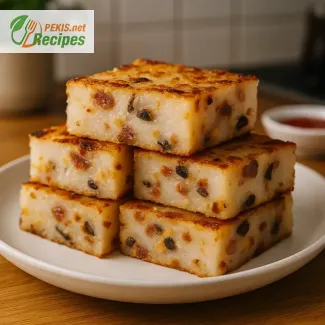
Creamy Pumpkin Soup with Ginger is a dish that embodies the flavors of autumn with its rich, velvety texture and spicy warmth from ginger. This versatile soup has become a favorite around the world, offering a comforting, nourishing, and nutrient-dense meal ideal for cool days or as a festive starter. Its earthy sweetness from the pumpkin harmonizes beautifully with the zesty, peppery bite of ginger, while optional additions like coconut milk, herbs, and spices add further layers of depth and richness. Beyond its delicious taste, this soup also provides notable health benefits, making it a powerhouse of flavor and nutrition.
Why Creamy Pumpkin Soup with Ginger is so Popular
This dish has gained immense popularity due to its smooth, indulgent texture and its inherent comforting qualities. The creaminess often comes from the pumpkin itself, a rich, starchy vegetable that, when blended, takes on a silky consistency. For those seeking a dairy-free option, this soup can still maintain its creaminess through the use of coconut milk or almond cream, which complement the natural sweetness of pumpkin while adding their own flavor profiles. This versatility makes creamy pumpkin soup with ginger suitable for a range of dietary preferences, including vegan, vegetarian, gluten-free, and dairy-free diets.
Additionally, the addition of ginger elevates this soup to a unique culinary experience. Ginger’s spiciness not only adds depth and intrigue but also offers anti-inflammatory and immune-boosting properties. For many, this soup is a go-to during colder months to ward off seasonal colds and support digestion.
Uses and Occasions for Creamy Pumpkin Soup with Ginger
Creamy pumpkin soup with ginger is extremely versatile and can be used in various contexts:
- Seasonal Starter: Often served as a starter dish during autumn and winter festivities, its light yet satisfying texture makes it an excellent way to warm up the palate without overwhelming it.
- Main Course: For a filling and healthy main course, many pair the soup with hearty bread or whole grains like quinoa or farro, which add fiber and protein, making it a well-rounded meal.
- Health Boost: The health-conscious frequently turn to this soup for its nutritious profile. The combination of pumpkin’s vitamins, fiber, and antioxidants with ginger’s anti-inflammatory properties makes it a wellness-focused choice that is gentle on the stomach and nourishing for the body.
- Lunch or Light Dinner: This soup is ideal for a quick yet luxurious lunch or a light dinner, often enhanced with toppings like toasted pumpkin seeds, yogurt, or herb-infused oils for added texture and flavor.
Variations of Creamy Pumpkin Soup with Ginger
Creamy pumpkin soup with ginger can be adapted in many ways, each bringing a unique twist to the classic. Here are some popular variations:
- Classic Creamy Pumpkin Soup: This version focuses on the basics – pumpkin, ginger, and a cream base. It's simple yet flavorful, highlighting the natural sweetness of pumpkin and the warmth of ginger. Some might use vegetable or chicken stock to add depth to the flavor, while a touch of cream or milk makes it satisfyingly creamy.
- Thai-Style Pumpkin Ginger Soup: This variation adds a Thai-inspired twist with coconut milk, lemongrass, and Thai red curry paste, offering a spicy, aromatic profile. The ginger in this recipe shines as a balancing spice against the creamy, rich coconut milk, with added spices bringing a warm complexity.
- Roasted Pumpkin and Ginger Soup: Roasting the pumpkin before blending deepens the earthy, caramelized flavors of the soup, adding a slightly smoky undertone. Roasting also enhances the natural sweetness of the pumpkin, making it a great base for savory and warm spices like cumin or coriander.
- Spiced Pumpkin and Ginger Soup: Here, additional spices such as cinnamon, nutmeg, and cloves are added, which brings out the pumpkin’s inherent sweetness and makes it a perfect holiday favorite. The ginger cuts through the sweetness, giving a balanced flavor that’s rich yet not overly sweet.
- Pumpkin and Carrot Ginger Soup: In this variation, carrots are added to the base for an extra layer of sweetness and vibrancy. Carrots blend seamlessly with pumpkin, enhancing the color and flavor profile, while ginger brings out their earthy notes. This version is especially appealing to those who enjoy bright, colorful soups with a hint of natural sweetness.
- Ginger-Turmeric Pumpkin Soup: Adding turmeric to the pumpkin and ginger base provides an extra anti-inflammatory boost and a gorgeous golden hue. Turmeric’s subtle bitterness complements the sweetness of pumpkin, while ginger helps accentuate the healing properties of both spices.
Nutritional Benefits and Health Implications
Pumpkin is a nutrient-rich food packed with vitamin A, which supports eye health, vitamin C for immunity, and fiber for digestive health. Its antioxidant content, including beta-carotene, makes it beneficial for skin health and protection against cellular damage. Ginger, on the other hand, is celebrated for its anti-inflammatory and antioxidant properties. It has been shown to improve digestion, reduce nausea, and aid in alleviating cold symptoms, making it a potent addition to this already nutritious soup.
Together, these ingredients make the soup a great choice for those seeking to:
- Boost Immune Health: High in antioxidants and vitamins that support immune function.
- Support Digestion: Both pumpkin’s fiber and ginger’s digestive properties help soothe the stomach and support gut health.
- Reduce Inflammation: The ginger-turmeric combination, if used, acts as a powerful anti-inflammatory, ideal for reducing body inflammation and soothing aches.
Tips for Enhancing Creamy Pumpkin Soup with Ginger
- Use Fresh Ingredients: Fresh pumpkin and ginger will give the soup the best flavor and nutritional value. Pre-roasting the pumpkin can intensify its natural sweetness.
- Adjust the Ginger: For those who enjoy a stronger kick, add extra ginger. For a milder spice, reduce the amount to balance the creaminess without overpowering.
- Experiment with Toppings: Adding a dollop of yogurt, a drizzle of olive or truffle oil, or a sprinkle of toasted pumpkin seeds can provide a pleasant contrast in texture and flavor, elevating the overall taste.
- Season Well: While pumpkin has a natural sweetness, adding a touch of salt, pepper, and perhaps a hint of chili can bring out the soup’s flavors.
- Blend for Perfect Texture: Blending the soup well gives it a smooth, luxurious texture. For added richness, try blending with coconut milk or a touch of cream for a velvety finish.
Creamy Pumpkin Soup with Ginger is not just a seasonal favorite; it’s a dish that embodies warmth, health, and versatility. Its adaptability and robust flavor profiles make it a beloved choice for a variety of palates and preferences, from simple and classic to creatively spiced variations. Whether enjoyed as a starter or a main course, it remains a dish that nourishes the body and satisfies the senses.
- Prepare the Pumpkin: Begin by peeling and dicing the pumpkin into even-sized cubes. This will ensure it cooks quickly and evenly.
- Sauté the Onion and Garlic: In a large pot, heat the olive oil over medium heat. Add the chopped onion and sauté until softened and translucent, about 5 minutes. Add the minced garlic and grated ginger, cooking for an additional 2 minutes until fragrant.
- Add Pumpkin and Broth: Add the diced pumpkin to the pot, stirring to combine with the onion mixture. Pour in the vegetable broth and bring to a boil, then reduce to a simmer. Cover and cook for 20-25 minutes or until the pumpkin is tender and can be easily pierced with a fork.
- Blend the Soup: Once the pumpkin is fully cooked, use an immersion blender to blend the soup until it reaches a smooth consistency. Alternatively, transfer the soup in batches to a blender, blending until smooth and creamy.
- Add Coconut Milk: Return the soup to the pot (if using a blender) and add the coconut milk. Stir thoroughly to combine, then let the soup simmer for an additional 5 minutes to allow the flavors to meld. Adjust the salt and pepper to taste.
- Serve: Ladle the creamy pumpkin soup into bowls. Garnish with fresh herbs, a swirl of extra coconut milk or yogurt, or sprinkle with roasted pumpkin seeds for extra texture.
Enjoy this cozy, creamy pumpkin soup with the aromatic zing of ginger for a satisfying and nutrient-packed meal!
Creamy Pumpkin Soup with Ginger offers a blend of ingredients that provide valuable nutrients, antioxidants, and energy-supporting elements essential for maintaining health. Here’s a breakdown of how these ingredients benefit the body:
Key Nutritional Impact of Ingredients
Pumpkin
Pumpkin is a nutrient-dense vegetable rich in vitamins A, C, and E and fiber. One of the standout nutrients in pumpkin is beta-carotene, which the body converts into vitamin A, supporting vision health, immune function, and cellular growth. Vitamin C in pumpkin acts as an antioxidant, helping combat free radicals that cause cellular damage and promoting collagen synthesis, which is crucial for skin health and wound healing.Additionally, the fiber content in pumpkin aids digestive health by adding bulk to the stool and supporting healthy gut bacteria, which are essential for nutrient absorption and immune health. The fiber also helps regulate blood sugar by slowing down the digestion of carbohydrates, making pumpkin a good choice for those managing blood sugar levels.
Ginger
Ginger is revered for its anti-inflammatory and antioxidant properties. The primary bioactive compound in ginger, gingerol, has been shown to help reduce nausea, muscle pain, and inflammation in the body. For digestive health, ginger supports gut motility and reduces bloating, making it helpful for individuals with digestive discomfort.Ginger also acts as a thermogenic agent, meaning it slightly raises body temperature and can support metabolic processes. This may increase calorie burning and improve digestion, as well as support circulation, which is particularly beneficial during colder months.
Coconut Milk
Coconut milk provides a creamy texture and is a source of healthy fats called medium-chain triglycerides (MCTs). Unlike long-chain fats, MCTs are metabolized quickly, providing a quick energy source without spiking blood sugar levels. Coconut milk is also rich in lauric acid, which has antibacterial and antiviral properties, supporting immune health.While coconut milk is high in saturated fat, these plant-based fats can increase HDL cholesterol (the “good” cholesterol) levels, which may benefit cardiovascular health when consumed in moderation. Additionally, the fats in coconut milk aid in fat-soluble vitamin absorption, particularly vitamins A and E from the pumpkin.
Garlic and Onion
Both garlic and onion contain sulfur compounds, particularly allicin in garlic, which is known for its antimicrobial and antioxidant properties. These compounds help support immune health and have shown benefits in reducing blood pressure and cholesterol levels.Garlic and onion are also rich in prebiotic fiber, which serves as food for the beneficial bacteria in the gut. A balanced gut microbiome contributes to better digestion, immunity, and even mood regulation, as it influences gut-brain interactions.
- Olive Oil
Olive oil provides healthy monounsaturated fats, which are known to support heart health by reducing LDL cholesterol levels and improving blood vessel function. Olive oil is also high in antioxidants, including vitamin E, which supports skin health and cell protection. These healthy fats are crucial for nutrient absorption and play a role in reducing inflammation, contributing to overall heart health.
Vitamins and Their Benefits
- Vitamin A
Primarily sourced from beta-carotene in pumpkin, vitamin A is essential for eye health, particularly in low-light conditions. It also supports immune function by maintaining the integrity of skin and mucosal barriers, which are the body’s first line of defense against pathogens. - Vitamin C
Found in pumpkin and onion, vitamin C is a powerful antioxidant that supports immune health and skin integrity by promoting collagen production. This vitamin also aids in iron absorption, which is particularly beneficial when paired with plant-based iron sources. - Vitamin E
Present in both pumpkin and olive oil, vitamin E is another antioxidant that protects cells from damage and is especially beneficial for skin health. It helps reduce inflammation and supports immune function, making it valuable in a nutrient-dense soup that aims to nourish the body.
Macronutrient Impact
- Carbohydrates
The carbohydrates in pumpkin are complex and provide sustained energy without causing rapid spikes in blood sugar. Fiber in pumpkin slows digestion, supporting blood sugar regulation and increasing satiety. This makes the soup filling and satisfying, ideal for those managing energy levels throughout the day. - Proteins
While relatively low in protein, the soup contains small amounts from the coconut milk and pumpkin. Adding a protein-rich garnish like seeds or a dollop of yogurt can further balance the meal and make it more filling. - Fats
Coconut milk and olive oil contribute healthy fats, which are necessary for the absorption of fat-soluble vitamins (A, D, E, K). These fats help support brain function, hormone production, and joint lubrication. Additionally, the MCTs in coconut milk provide a source of quick energy, enhancing the soup’s nutritional balance and supporting metabolic health.
Potential Health Benefits
- Supports Immune Health
The high vitamin A and C content, along with ginger’s anti-inflammatory properties, make this soup a fantastic choice for strengthening immune defenses. The sulfur compounds in garlic and onion further support antiviral and antibacterial defenses, helping the body fight off seasonal colds and infections. - Promotes Digestive Health
The fiber in pumpkin and prebiotics in garlic and onion support gut health by feeding beneficial bacteria and promoting regularity. Ginger’s ability to relieve nausea and bloating adds to the digestive benefits, making this soup gentle on the stomach and suitable for those with digestive sensitivities. - Anti-Inflammatory and Antioxidant Properties
Ginger, vitamin E, and the antioxidants in olive oil and garlic help reduce inflammation and protect cells from oxidative damage. Regular consumption of antioxidant-rich foods like this soup can lower inflammation levels and reduce the risk of chronic diseases associated with oxidative stress. - Heart Health
The unsaturated fats in olive oil, coupled with fiber from pumpkin, contribute to heart health by managing cholesterol levels. The antioxidants, particularly vitamin E, support vascular health by reducing inflammation, which helps protect against heart disease and other cardiovascular issues. - Weight Management and Satiety
Pumpkin’s fiber content helps promote a feeling of fullness, aiding in weight management by reducing the likelihood of overeating. The healthy fats in coconut milk and olive oil also support satiety, making this soup a satisfying choice for a light meal or appetizer.
Allergens and Alternative Ingredient Advice
- Coconut (coconut milk): For those allergic to coconut, replace coconut milk with almond milk or oat cream, which provide a creamy texture and mild flavor without the risk of allergens.
- Garlic and Onion: For those with allium sensitivities, leek or asafetida powder can provide a similar flavor profile without causing irritation, though they lack some of the antimicrobial benefits.
This creamy pumpkin soup with ginger is more than just a warming dish; it’s packed with vitamins, antioxidants, and fiber that offer significant health benefits. Its nutrient profile supports immunity, digestive health, and overall wellness, making it an ideal choice for anyone seeking a nourishing, delicious meal that aligns with their health goals.
Creamy pumpkin soup with ginger is a nutritious, seasonal dish that can be a valuable addition to a balanced diet, especially during the colder months when the body benefits from warming, immune-supportive foods. This meal is best enjoyed as part of a varied weekly menu, ideally once or twice a week during autumn and winter. Including this soup regularly provides a rich source of vitamins A, C, and E, antioxidants, and fiber, all of which support immune health, digestion, and skin health.
Due to the healthy fats from coconut milk and olive oil, the soup also offers satiety and supports heart health, but it is advisable to balance it with other protein-rich meals throughout the week, as the soup itself is moderate in protein content. Adding a small protein boost—such as a sprinkle of seeds, a side of whole grain bread, or a dollop of yogurt—can help make it a more complete meal, especially if served as a main dish.
General Tips for This Recipe:
- Adjust the Ginger: For those who enjoy a milder flavor, start with a smaller amount of ginger and increase to taste. Ginger adds both flavor and health benefits, but it can be quite strong.
- Enhance Creaminess: If you’re aiming for an extra creamy texture, blend the soup well and consider adding a touch more coconut milk or cream, which creates a rich mouthfeel without overwhelming the pumpkin flavor.
- Add Crunch with Toppings: Garnishing with toasted pumpkin seeds or nuts not only adds texture but also increases protein and healthy fats, making the soup more filling and nutritionally complete.
- Use Fresh, Seasonal Ingredients: For maximum flavor and nutrition, use fresh, in-season pumpkin, and high-quality ginger. This enhances the natural sweetness and spiciness of the dish.
By incorporating creamy pumpkin soup with ginger thoughtfully into a weekly meal plan, you can enjoy its comforting flavors and health benefits in moderation while supporting overall dietary variety.
- Coconut: Coconut milk is a potential allergen. Substitute with almond milk or oat milk for a dairy-free option, or use heavy cream if there are no dairy restrictions.
- Garlic and Onion: These can be swapped out for leek for those sensitive to alliums, as it offers a mild, onion-like flavor without the harshness.





